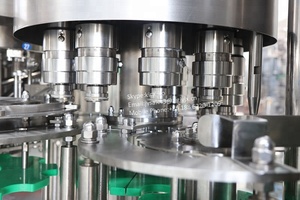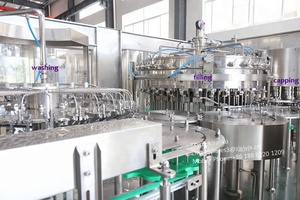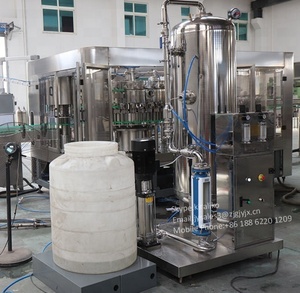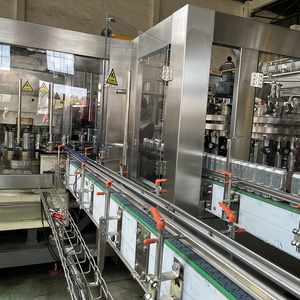
All categories
Featured selections
Trade Assurance
Buyer Central
Help Center
Get the app
Become a supplier

(1050 products available)




















































The isobaric monoblock machine comes in various types depending on the needs of the business. Here are some of the models
Isobaric monoblock machine for PET
An isobaric monoblock machine for PET (Polyethylene Terephthalate) plays a crucial role in the production of carbonated beverages. It streamlines the complex process of bottling fizzy drinks by integrating multiple stages into a single unit. This helps maintain efficient production lines while ensuring the quality of the final product. The isobaric monoblock operates by preforming the bottle, filling it with the carbonated beverage, and then closing it with a cap - all within one machine. This reduces handling time, ultimately improving the production rate.
Isobaric monoblock machine for glass
The isobaric monoblock machine for glass bottles offers a comprehensive solution for filling and capping glass containers, primarily used for carbonated beverages. This machine's efficient operation helps maintain the quality and carbonation of the drink, reducing the risk of excess exposure to air. The entire process of this machine from filling the glass bottle to capping it is done within a single unit. This not only enhances productivity but also streamlines the bottling process. The integration of multiple functions into one machine helps to simplify operations and increase efficiency in industrial settings.
Isobaric monoblock machine for cans
The isobaric monoblock machine for cans is specifically engineered to handle the unique requirements of can filling and sealing. It helps to maintain a competitive edge in the rapidly growing canned beverage sector by offering precise control over the filling process. The monoblock design promotes efficient workflow by consolidating the filling and sealing operations into a single unit. This reduces production time and enhances the overall efficiency of the bottling process.
Maintenance of isobaric monoblock machines ensures they always work at optimal capacity and helps to extend their lifespan.
For effective maintenance, it is important to go through the machine’s manuals to understand the operating parameters. Then, inspect the machine regularly to know what parts require lubrication and their maintenance schedules. Identify the replacement parts of the equipment that usually require servicing and set a routine for constant replacement. The practice will ensure the machine runs smoothly at all times. Employ technical experts familiar with the machine’s operating principles and structure to handle its maintenance and repairs.
While undertaking the machine's regular cleaning process, ensure that any solid and liquid waste is stripped away thoroughly. The process will minimize contamination of products during production. Also, ensure the equipment is dried completely before starting the production process to avoid product dilution. Please don't ignore any unusual sounds and features as the machine operates. They could indicate something wrong that requires immediate inspection and repair to avoid equipment failure.
Some common monoblock machine components that require regular inspection and maintenance include:
The isobaric monoblock machine has various applications in the beverage industry, and its uses continue to rise as technology improves. The following is an overview of some common usage scenarios for this machine:
Carbonated Soft Drink Plant
In a carbonated soft drink factory set up, the isobaric monoblock machine fills and caps bottles quickly and efficiently. This machine is popular in large-scale production facilities.
Beer Brewery
In a large brewing establishment, an isobaric monoblock machine can fill and cap bottles or cans of beer precisely while maintaining the right pressure and minimizing wastage. The machine's isobaric filling feature is suitable for preserving the beer's quality and preventing excessive foam formation during the filling process.
Juice and Tea Production
In a facility that produces carbonated juice drinks or iced tea, the machine can help with bottling and capping operations. The isobaric monoblock machine will allow for high-speed filling and capping, ensuring efficient production and packaging.
Water Bottling
In a mineral water bottling plant, the isobaric monoblock machine can apply different bottle caps (including anti-tamper sports caps) to premium bottled water. The machine ensures quick capping, product protection, and secure closure for the end user.
Contract Packing and Co-Packing
In a facility that offers contract packing or co-packing services for carbonated beverages, the machine will fill and cap bottles for different brands and flavors on behalf of external clients. The monoblock machine will provide flexibility, high-speed operation, and accuracy in handling various recipes and bottle designs.
Cosmetic and Pharmaceutical Industry
In the cosmetic or pharmaceutical industry, the isobaric monoblock machine can be used in the bottling and capping of products that require precise filling and secure sealing. For example, the machine can be used for effervescent tablets in water.
Determine production capacity needs:
When selecting isobaric monoblock machines, it is essential to evaluate the required production capacity. This is determined by factors such as retail and expected growth rate, available staff capacity, and the number of functional and efficient downstream machines. Consider whether the machine's automated tasks will minimize bottlenecks and allow for extra capacity.
Evaluate available floor space:
The compact design of monoblock machines makes them suitable for facilities with limited floor space. Yet, it is still crucial to determine the area accessible for equipment and benchmark machine dimensions against it. When it comes to setup, workflow, and employee safety, a sufficient amount of room must be provided.
Understand the types of beverages produced:
Identifying the types of drinks that need to be processed can help narrow down the options. There are specific requirements for temperature control, carbonation retention, and bottle sealing procedures. Moreover, customizable settings and filtration systems are essential.
Consider the level of automation required:
Machines with different degrees of automation might satisfy distinct demands. Depending on crucial factors like the need for fewer employee hours, operating costs, and the complexity of other business units, the option between fully automated and semi-automated devices should be thoroughly considered.
Compare investment cost vs. return:
Since the purchase of an isobaric monoblock machine constitutes a major investment, a thorough analysis of the required capacity, area, and degree of automation should be balanced against the investment expense and future returns. Improved efficiency, product quality, and reduced workforce requirements all contribute to a speedy return on investment.
Prioritize supplier support:
A thorough evaluation of the suppliers' customer assistance is well warranted. The importance of supplier assistance in areas such as technical support and spare parts availability during the lifespan of the monoblock machine need to be highlighted. Also, assistance in areas like installation, set-up and user training enables a smooth transition to new technologies.
Q1: What is an isobaric filling machine?
A1: An isobaric filling machine is designed to fill containers with beverages while maintaining a constant pressure throughout the filling process. This isotonic method ensures that the beverage's carbonation is preserved as it is being filled into the container. Isobaric filling machines are commonly used in the bottling industry for carbonated soft drinks, sparkling water, and beer.
Q2: What is the difference between isobaric and isometric filling?
Isobaric and isometric filling refer to different methods of filling containers, often used in the context of filling machines for liquids. The following table shows how they differ.
Q3: What are the advantages of the isobaric monoblock machine?
A3: The isobaric monoblock machine has a lot of benefits, so it is popular in the industry. It can be used to compress, fill, and seal containers of carbonated drinks at a constant pressure. This quick-changing machine can help to increase productivity while reducing the cost of production and space.